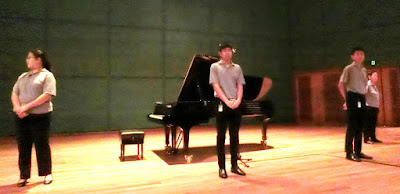SOLO PIANO RECITALS by
See Ning Hui (Tuesday, 7 August 2018 )
Yap Sin Yee (Wednesday, 8 August 2018 )
Clarisse Teo (Sunday, 12 August 2018 )
Esplanade Recital Studio
An edited version of this review was published in The Straits Times on 15 August 2018 with the title "Different moods from a trio of pianists".
It
seems an astonishing fact that all of this summer's solo piano recitals
featuring local pianists were given by young women. This should come as no big
surprise since some of history's great pianists were from the fairer gender.
The names of Clara Schumann, Wanda Landowska, Myra Hess and Martha Argerich all
come to mind. The piano playing scene here should be no different.
The
two recitals held on Tuesday and Wednesday were part of Allure, a mini-piano
festival presented by the Kris Foundation. London-based Singaporean See Ning
Hui displayed a mastery of six composers of different eras and styles. She
opened with a slick account of Chopin's Second Scherzo, revealing a
pearly tone with sharp contours smoothened over. Two Scarlatti Sonatas keenly
contrasted staccato with legato playing, polar opposites of sound production
and projection.
While
her advocacy of living composers, Korean Unsuk Chin (Etude No.6 “Grains”)
and Briton Thomas Ades (Darknesse Visible), was spirited and admirable,
it was See's juxtaposition of Sonatas by husband-and-wife Robert and
Clara Schumann which sealed the deal. Both cast in G minor, Clara's salon-like
charm and Robert's blistering passion were the toast of the evening's
offerings.
Boston-based
Malaysian pianist Yap Sin Yee was the 1st prizewinner in the 2013
National Piano Competition while at the Yong Siew Toh Conservatory. Her
programme was entirely Romantic, beginning with Debussy's Etude No.11 as
a cystalline icebreaker. Then followed a chronological history of the sonata
form.
Beethoven's
late Sonata No.30 in E major (Op.109) revelled in abrupt changes in
dynamics and mood with the central movement's outburst as a focal point. The
Theme and Variations of the final movement were beautifully shaped, with the
noble return of its lovely sarabande subject.
Robert
Schumann's three-movement Fantasy in C major (Op.17) was a statement of
love which received a most passionate response. Bliss turned to orgasmic
ecstasy for Scriabin's Fifth Sonata, where wrong and missed notes were a
small price to pay for going for broke. Here, Yap 's audacity
totally trumped timidity.
 |
| Pianists See Ning Hui and Yap Sin Yee with Kris Tan and project manager Laura Peh. |
Clarisse
Teo was a graduate in law before deciding to pursue music full-time at the
Royal Conservatoire of Scotland in Glasgow
For
these, Frenchman Vincent D'Indy's Theme Varie, Fugue Et Chanson and
Soviet composer Anatoly Alexandrov's psychedelic Fourth Sonata, she
displayed utter confidence and a fearless disregard for their technical
complexities, while making this arcane music sound totally fresh and natural.
Whoever thought that Singapore










No comments:
Post a Comment